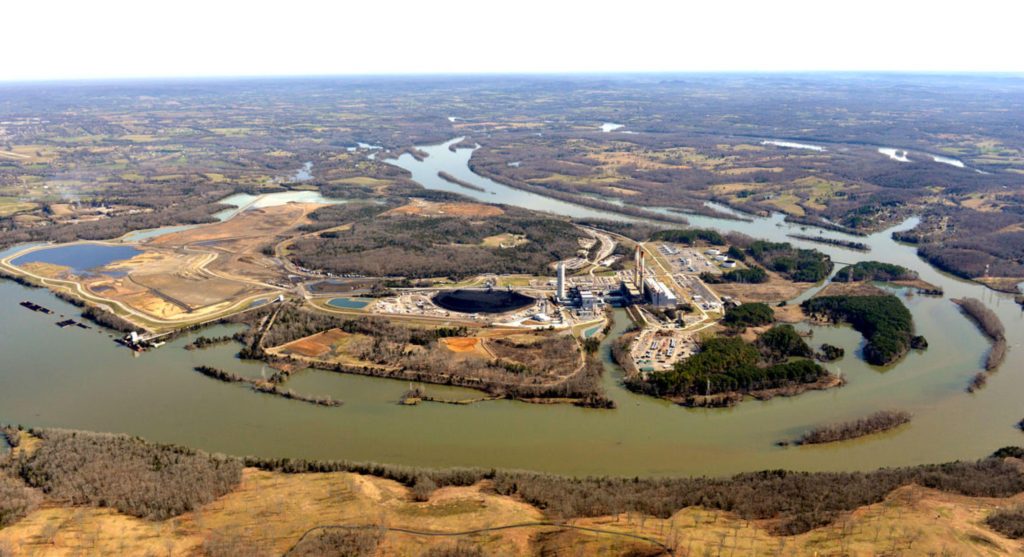Written by Jenilyn M. Brhel
On September 24, 2018, the United States Court of Appeals for the Sixth Circuit reversed a District Court order that required the Tennessee Valley Authority to remove deposits of coal ash from one of its power plants, finding that the Clean Water Act does not apply to pollutants that reach protected waters via “hydrologically connected” groundwater channels.
Background
In 1972, Congress passed the Clean Water Act, establishing protocols for the regulation of water-based pollutants in order to “restore and maintain. . . the Nation’s waters.”
Tennessee Valley Authority (“TVA”) is an electricity provider for approximately 565,000 households in the Nashville, Tennessee region. The company runs several coal-fired plants, one of which is located along a part of the Cumberland River called Old Hickory Lake, a reservoir and recreational destination for millions of people each year.
At its plants, TVA produces waste byproducts known as coal combustion residuals (“CCRs”). CCRs contain carcinogens such as arsenic. The CCRs are treated through a process known as “sluicing”, in which water is mixed with coal ash and allowed to settle in on-site ponds.
TVA treats its CCRs at a series of unlined ponds known as the Complex. The Complex is located on a karst terrain adjacent to the Cumberland River under which sinkholes, fissures and caves create conduits through which groundwater easily flows. These nooks and crannies allow CCRs from the Complex’s unlined ponds to leak into groundwater that flows through the karst terrain and into the Cumberland River.
Pursuant to effluent limitations and other protocols established by the CWA, the Environmental Protection Agency issued a permit to TVA that allows the company to discharge not all, but some of its “sluiced” coal combustion wastewater directly into the Cumberland River via a pipe called Outfall 001.
Issue
The plaintiffs, two conservation groups from Tennessee who enjoy Old Hickory Lake as a recreational destination, filed suit on April 14, 2015. They did not contend with TVA’s permitted CCR direct discharge through Outfall 001, but rather argued that the company was in violation of the CWA because of CCR leaks entering Old Hickory Lake via “hydrologically connected” groundwater channels originating from the Complex’s coal ash ponds.
The court rested its decision on its interpretation of the CWA’s distinction between point-source and nonpoint-source pollutants. The precise statutory language in question defined the discharge of a pollutant as “any addition of any pollutant to navigable waters from any point source.”
The plaintiffs argued that the meaning of the statute encompassed pollutants entering the waterway through “hydrogically connected” channels, arguing that because the pollutants entered the river through leaks in the lined ponds, the ponds should be considered a point source.
TVA argued that the meaning of point-source was limited to direct discharges, like those of Outfall 00, and that the statute did not mean to include the migration of pollutants through groundwater.
Ruling: Pollutants Must Have a Point-Source
The District Court for the Middle District of Tennessee found for the plaintiffs and ordered TVA to excavate the coal ash in the Complex and remove it to a lined facility.
The Court of Appeals for the Sixth Circuit reversed the District Court’s decision, finding that a pollutant must be placed directly into a protected water through a specific and identifiable point source. The court focused on the language of the statute regarding “discernible, confined and concrete conveyance(s).” It found that groundwater does not constitute a nonpoint-source conveyance and that karst-related leaks did not violate the provisions of TVA’s permit. The Court further stated that any regulation of pollutants through nonpoint-source conveyances does not come under the purview of the CWA.
Dissent Finds Distinction Arbitrary
The dissent argued that the law could be easily circumvented as defined by the majority. The contention is that if the statute of the language meant that pollutants must come from a direct point source, then companies could circumvent the law simply by arbitrarily moving their drainage pipes a few feet away from the water so that they are not feeding “directly” into it.
Looking Ahead
While the Court ultimately recognized that the pollution presented a significant environmental issue, it opined that the Clean Water Act was not the proper tool to address the problem.
However, both the Fourth District and the Ninth District have ruled to the contrary in recent decisions, finding that an intermediary like groundwater does not necessarily defeat liability. These differences in opinion raise the question of whether a case like this might soon end up at the Supreme Court of the United States.
Sources
33 USCS § 1251.
Arsenic, Nat’l Inst. of Envtl. Health Scis. (last visited Sep. 30, 2018).
Coal Ash Basics, U.S. Envtl. Prot. Agency (last visited Sep. 30, 2018).
History of the Clean Water Act, U.S. Envtl. Prot. Agency (last visited Sep. 30, 2018).
Kenneth Hall, Federal Appeals Court Overturns Tennessee Coal Ash Cleanup Order, JURIST, (last visited Sep. 30, 2018).
Old Hickory Lake, US Army Corps of Eng’rs, (last visited Sep. 30, 2018).
Tenn. Clean Water Network v. TVA, No. 17-6155, 2018 U.S. App. LEXIS 27237 (6th Cir. Sep. 24, 2018).
Photo courtesy of Southern Environmental Law Center.

